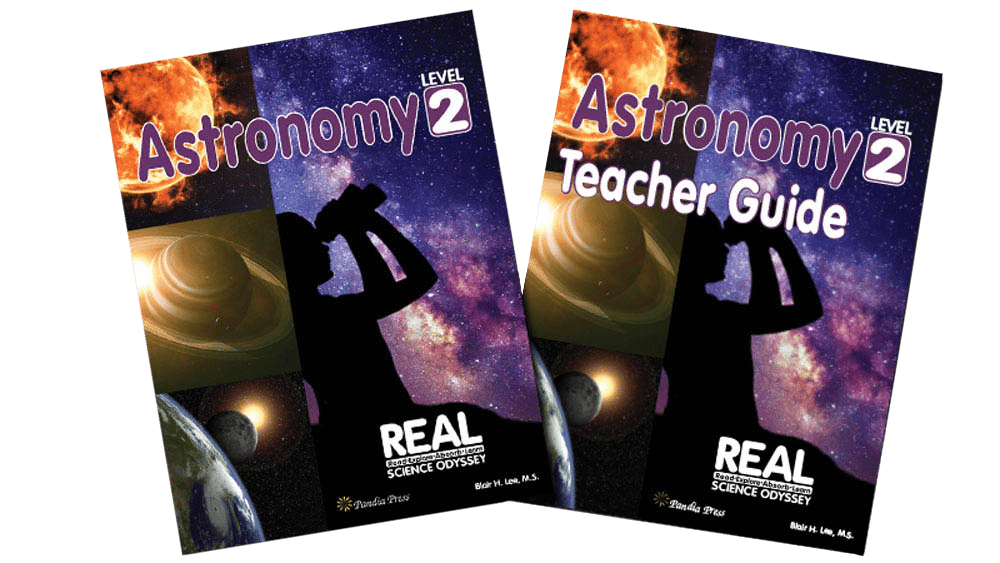Review of R.E.A.L. Science Odyssey Astronomy 2
R.E.A.L. Science Odyssey Astronomy 2 from Pandia Press brings top quality secular science into your home or classroom in an engaging hands-on manner. Scientist and author, Blair Lee, has a conversational writing style that opens up serious science topics to students in a way that invites them on a journey through learning. The combination of thorough science education, fun labs and activities, and the author’s ability to share vast amounts of information without overwhelming a novice makes RSO Astronomy 2 an excellent course for both students who love science, and those who do not. The writing style, uncommon for a textbook, paired with the rigorous academic material it teaches allows this course to meet the needs of students throughout the publisher’s recommended 6th – 10th grade range.
The student text for this course functions as textbook, workbook, and lab book all in one, which makes organizing this course quite easy for students, parents, and teachers. The text is divided into three units, each containing four chapters,and a unit exam. In each chapter, students will learn through thought provoking written lessons as they build a solid foundation of science concepts. These lessons are thorough, teaching not only astronomy, but also explaining the chemistry, physics, and math needed to truly understand the material. Students will explore these concepts further with hands-on labs, activities, and scientific models. There is an outstanding focus on scientific modeling woven through the entire course. Students will not only learn how and why scientist use scientific models, but also gain a deeper understanding through using existing working scientific models, as well as creating and developing their own. Some labs in this course require written lab reports, this formulaic writing is an important skill every student should learn. There are also labs with math components, as math and science often go hand in hand. All of the math is clearly explained and examples are given. This is an excellent example for students of how mathematics is applied in subjects beyond their math studies.
Through the twelve part Famous Science Series, students develop and expand research skills while learning interesting history related to astronomy, including topics like famous scientists, scientific discoveries, and space crafts and programs. While the questions in this series will help guide student’s research, how that research is done is left more open ended. This allows you to easily adapt these assignments to the appropriate level for your student. My 9th grader found researching Edwin Hubble for chapter 2, William and Margaret Huggins for chapter 4, and Tycho Brache and Johannes Kepler for chapter 6 quite fascinating. He will be expanding what he learned in the Famous Science Series into more formal research papers on each. The “Show What You Know” section at the end of each chapter gives students a chance to demonstrate the knowledge they’ve gained and provides parents and teachers with a quick and easy way to assess if students have a solid understanding of key concepts. Because each chapter builds on the one prior, this also lets you know if any information should be reviewed before moving on. Doing the “SWYK” section orally led to some long and fascinating conversations in my house.
I have often heard people ask if a teacher’s guide is really necessary, in this case my answer is absolutely yes. The teacher’s guide for RSO Astronomy 2 is so much more than just an answer book. Of course it does include answer keys and lesson reviews, but also guides to help with scheduling, grading, learning goals for each chapter, details on the math used in various labs, and more. Need a more detailed explanation or want to dig deeper into a topic? Each chapter in the teacher’s guide includes lists of books, videos, websites, and/or podcasts to explore. This pair of books provide an exciting and solid astronomy education regardless of your own science background.
R.E.A.L. Science Odyssey Astronomy 2 is presented in a way that is open, inviting, fun, and user friendly for students, parents, and teachers. Yet it never over simplifies or compromises on the quality of the academic material. Whether your students dream of a career exploring the universe or just enjoy gazing at the night sky, upon completion of this course they will have a thorough understanding of the core principles of astronomy and the processes used to develop those principles…and will certainly have some fun while learning it.
Sign up here for a chance to win R.E.A.L. Science Odyssey Astronomy 2 Student and Teacher Guide!
The Winner will be announced September 10, 2017.
Check out our post on observing the Perseid Meteor Shower here.

